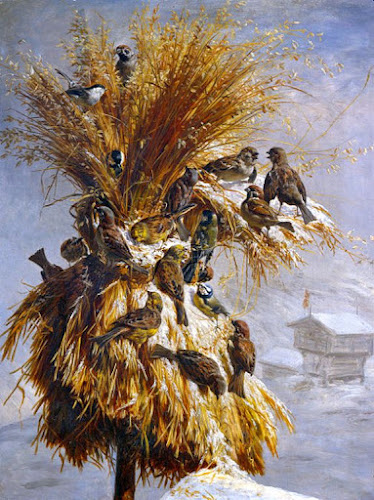(A Yule related post inspired by the Old Wife's Neck.)
Our Scandinavian cousins have preserved a Yuletide custom known as the Julenek - a sheaf of grain stalks kept over from the summer harvest, which is then hung up outside on Christmas eve. The custom was apparently condemned in the 1700's as having pagan origins, but today it is still a popular Christmas decoration in Nordic countries.
'Nek' is an old Scandinavian word for a harvested sheaf of grain (oats, barley, wheat etc) while Jule / Yule is the week long period around the winter solstice. So the Julenek is the 'midwinter Sheaf'.
Today, the purpose of the Julenek is said to provide a food supply for winter birds, and as a symbol of charity and caring for animals at Christmas. A story attached to the Julenek tradition tells how a poor man gave one of his last sheaves to provide food and shelter for the birds on Christmas Eve. The birds prayed that God would help the man, and the following morning the grains of the Julenek were turned to gold. This Christian charity element may have been emphasised to allow the continued use of the Julenek after the accusations that it had pagan overtones.
Older rural beliefs connected with the Julenek suggest that it may have originally been a midwinter offering, in which birds played a divinatory role. It seems to have been important that the Julenek was placed as high as possible on the farm, such as the roof ridge of the barn, or alternatively, on the top of a tall pole (see illustrations). Why might this be?
At harvest time in some parts of Scandinavia and Germany the last harvested sheaf (the nek) was left standing in the field as an offering to Odin, and called Odin's Share or Odin's horse fodder. A few months later at mid winter, Odin, as Jólnir (Yule Lord) was believed to lead the 'Wild Hunt' - a pack of supernatural riders and hounds in search of souls, who could be heard passing overhead on stormy winter nights.
Was the Julenek raised up as another offering to Odin and his horse as they
passed over the country at the mid winter festival, just as the last nek was
left out in the open for him at harvest time? If this was the original belief
behind the Julenek, then the hope must have been that the offering would be
accepted, and the Wild Hunt would pass over without troubling the farm.

|
|
Siegwald Dahl 1881 |
Once in position, the Julenek was closely observed in order to
draw omens and portents for the coming year. If many small birds (sparrows,
finches etc) came to the sheaf to eat the grain it foretold a good harvest the
following year. If only a few small birds came, then the harvest would be less
good. If larger birds such as the magpie came to the Nek, then this was not a
good omen, and those birds would be driven away. The worst outcome would be if
no birds at all came to the Julenek as this foretold misfortune or death on
the farm.
As seems to be the case with so much folklore, the passage of time has often obscured or confused the original beliefs behind a tradition. With the Julenek, the small birds seems to have represented fertility or good fortune in some way, perhaps being originally linked to one of the Norse or Germanic deities. There are references to the sparrow having a connection with death, and being a 'soul catcher', which might point to some lost association with the Wild Hunt. If this link did exist in the past, then the more sparrows feasting at the Julenek would be a sign that the offering had been accepted and the farm could expect a good year ahead.
Most of us do not have a Julenek handy, but we can maybe still put out some food for the birds, and hopefully look forward to a better new year.
Was hál, One and all.
Image credits
First image of a Julenek from
https://rofl.no/hjem/julenek
Image of a Juleneg atop a pole (1873) - from Nordiska Taflor (Nordic
paintings). public domain.
Image of Wodan's Wild Hunt" (1882) by Friedrich Wilhelm Heine. Public
Domain
Juleneck Birds by Siegwald Dahl (1881).
Julenek Card by artist Olaf August Hermansen (1849-1847)
Glædelig Jul postcard from
http://blog.dengamleby.dk/julehistorier/tag/juleneg/






Great post Graeme, thoughts of Stanghow (ON stong haugr ) and of course the nearby Carlin How
ReplyDeleteThanks - I had not thought about a stang connection - makes you wonder.
Delete